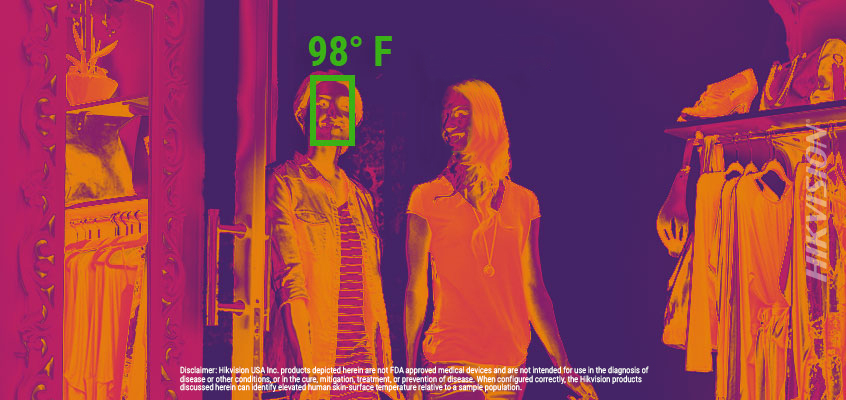Helping Retailers & Commercial Business Operate Safely with Hikvision Solutions for Skin-Temperature Screening, Mask Detection, Social Distancing and More

As businesses look toward the future, they need to find ways to adjust to the new normal. While the pandemic has made simple tasks such as public transit and grabbing a cup of coffee more complex, Hikvision offers technological solutions that can help retailers and commercial businesses operate safely.
We have a wide range of solutions to support multiple application needs. As temperature screening, mask detection and social distancing have become part of our every day lives, Hikvision is offering tailored solutions to meet these requirements.
- Highly Accurate Skin-Surface Temperature Screening
- Mask Detection with Alerts
- Touch-Free Entry and Exit with Customized Health Questionnaire
- Automated Social Distancing and Density Control
Temperature Screening: One of the CDC’s Recommendations for Reopening Business
Hikvision temperature detection solutions can help you easily and quickly pre-screen employees, visitors, customers and vendors before they enter your business. Pre-screening takes less than one second, is highly accurate, and it offers contactless measurement from a distance.
Hikvision’s highly accurate thermographic temperature screening cameras come in handheld, bullet and turret models and offer the following benefits.

Solutions Showcase
Hikvision has a full lineup of solutions that help organizations get back to business safely:
- Density Control and Social Distancing: Hikvision’s Dual-Lens People Counting Density Cameras can facilitate social distancing. Our indoor and outdoor models accurately count people, track occupancy, and measure distance between people. Find out more at this link.
- Touch-Free Entry and Exit: Our DS-K1T671TM-3XF Temperature Screening Terminal is an access control device integrated with high accuracy temperature screening. It can quickly measure skin-surface temperature and notify the user about abnormal temperature readings from a safe distance of 0.98 to 6.5 ft. (0.3 to 2 m). Learn more here.
- Temperature Pre-Screening from a Safe Distance: Using our Temperature Screening Terminal referenced above or using our line of highly accurate thermographic cameras that include bullets, turrets, and handheld models, skin-temperature screening is made simple. Learn more here about our range of temperature screening solutions.
- Mask Detection: The Hikvision Temperature Screening Terminal with Mask Detection integrates access control with high accuracy temperature screening for improved safety and security. Click this link to watch a video of the product in action.
- Touchless Temperature Self-Screening, Mask Detection & Customized Health Questionnaire: Provide a safe and streamlined process for access control, visitor reporting, and health status tracking with Hikvision’s Touchless Self-Screening Solution. This is a complete system that provides:
- Accurate temperature screening
- Mask detection with alerts
- Automated, touchless customized health questionnaire: User scans QR code to respond
- With normal temperature reading and approved health questionnaire, a visitor badge can be printed so the person can enter
Learn more on our website.
*Disclaimer: Hikvision USA Inc. products depicted herein are not FDA approved medical devices and are not intended for use in the diagnosis of disease or other conditions, or in the cure, mitigation, treatment, or prevention of disease. When configured correctly, the Hikvision products discussed herein can identify elevated human skin-surface temperature relative to a sample population.
